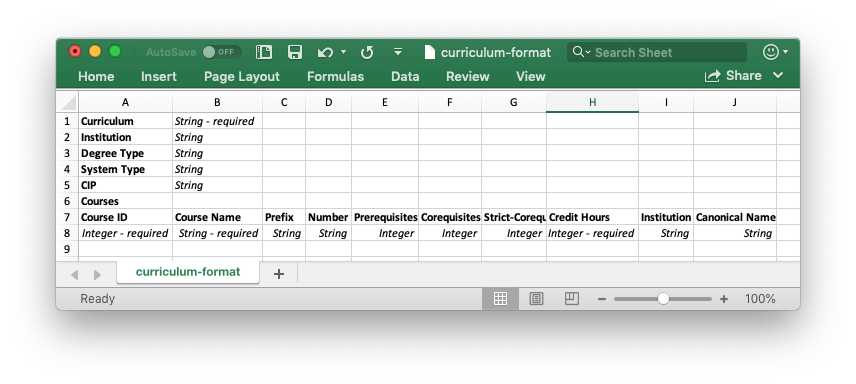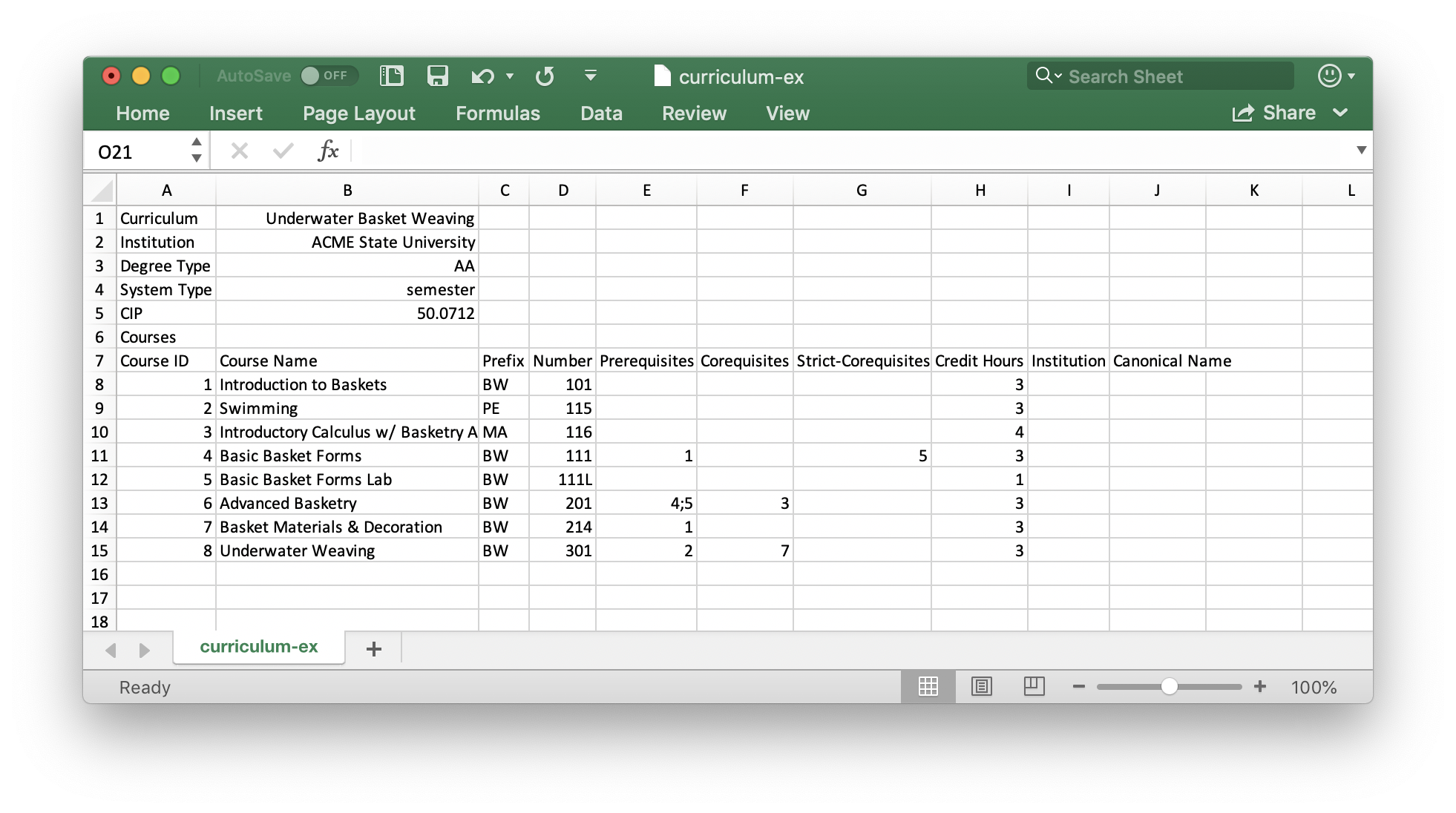Uploading Curricula and Degree Plans
In order to upload a curriculum or degree plan to the Curricular Analytics site, you simply need to specify them in a CSV file, and then upload them to your account.
What's the difference between a curriculum and a degree plan?
CSV files store data as comma-separated values, allowing data to be presented in tabular form. You can create CSV files with either a text editor or by using your favorite spreadsheet program. The specific formats required to specify a curriculum or a degree plan are provided below, along with examples.
After hitting the upload button, the file format will be analyzed for any errors, and if there are none, the curriculum or degree plan will be stored so that you can visualize it.
Curriculum File Format
The CSV file format used to store curricula is shown below:

The elements shown in boldface are required keywords that must appear in the curriculum CSV file, while the italicized elements are user supplied arguments. The italicized elements stipulate the input type, and whether or not the argument is required.
More specifically, the data that is expected to follow each keyword provided in the curriculum CSV file is described next:
- Curriculum
- The name of the curriculum/degree program (required).
- Institution
- The name of the institution offering the curriculum/degree program.
- Degree Type
- The type of degree that will be earned by completing the curriculum. Allowable values are: AA, AS, AAS, BA, BS.
- System Type
- The type of system the institution's operations on. Allowable values are: semester quarter
- CIP
- The Classification of Instructional Programs (CIP) code for the curriculum. See: https://nces.ed.gov/ipeds/cipcode
- Courses
- A keyword that appears on a line by itself (i.e., with no following data). A single header row should appear below this keyword, followed by the row-by-row list of courses associated with the curriculum. The required keywords in the header row, and the data that should appear below each header are as follows:
- Course ID - the unique integer ID of the course (required).
- Course Name - the name of the course (required).
- Prefix - the prefix associated with the course.
- Number - the number associated with the course.
- Prerequisites - a (semicolon separated) list of all required prerequisites, by Course ID.
- Corequisites - a (semicolon separated) list of all required corequisites, by Course ID.
- Strict-Corequisites : a (semicolon separated) list of all required strict-corequisites, by Course ID.
- Credit Hours - the number of credit hours associated with the course (required).
- Institution - the institution offering the course (may be different from the institution offering the curriculum).
- Canonical Name - the canonical (i.e., common) name used for the course.
Below is an example curriculum file that uses this format (download the file).
Column A course ID numbers are referenced in columns E, F, and G rather than the quantity or specific names of courses.
In the example below:
- Course ID 4 (Basic Basket Forms) requires a prerequisite of Course ID 1 (Introduction to Baskets) and has a strict co-requisite of Course ID 5 (Basic Basket Forms Lab).
- Course ID 6 (Advanced Basketry) requires a prerequisite of Course ID 4 (Basic Basket Forms) and Course ID 5 (Basic Basket Forms Lab) and a co-requisite of Course ID 3 (Introductory Calculus was Basketry Applications)(taken before or during this course per our terminology)

Degree Plan File Format
The CSV file format used to store degree plans is shown below:

The elements shown in boldface are required keywords that must appear in the degree plan CSV file, while the italicized elements are user supplied arguments. Notice that the italicized elements stipulate the input type, and whether or not the argument is required.
The data that is expected to follow each keyword provided in the degree plan CSV file is the same as those for curriculum CSV file above, with some additions:
- Degree Plan
- The name of the degree plan (required).
- Term
- This keyword appears at the end of the header row associated with courses (required). The term that a course should appear in as a part of a degree plan should be listed under this keyword.
- Additional Courses
- This phrase in file indicates the start of the additional courses section. The courses header is duplicated immediately below (that is, the Course ID, Course Name, etc.). Additional courses are courses that are found in the degree plan but not in the curriculum. These are typically preparatory courses and not included in most 4-year plans.
Below is an example degree plan file that uses the aforedescribed format, but does not include additional courses (download the file):

This degree plan satisfies the curriculum shown in the previous section. That is, if a student follows this degree plan, they will complete the curriculum.